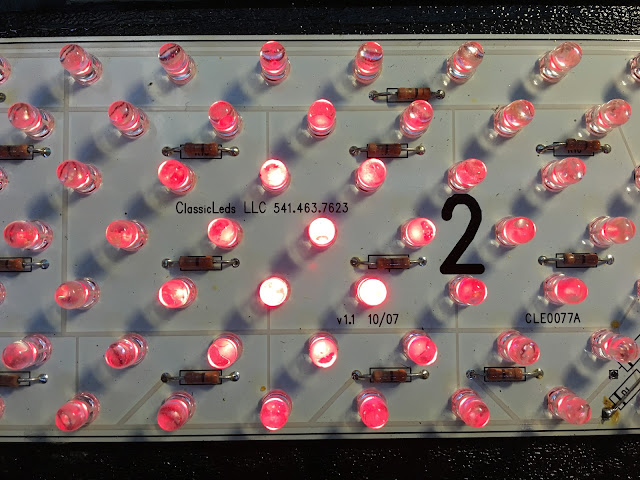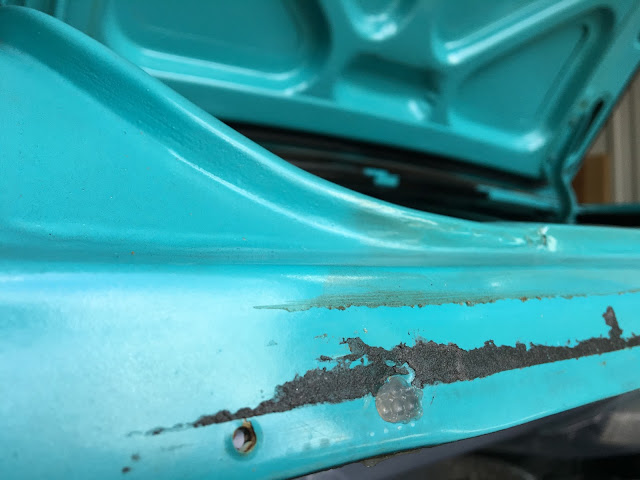Cylinder number 4 couldn't have been firing too well with some of the exhaust gases blowing out around the plug. The entire plug is covered with soot except the part covered by the boot. The rest of the plugs look pretty good with a nice healthy tan color, although 1 and 3 are kinda light. A few of them have fresh oil around the base and threads which means the valve cover gaskets are leaking a little so I ordered new gaskets along with new plugs.
My new push rod guide plates arrived; they're the correct 5/16" instead of the the 3/8" somebody else installed. You can read my previous post concerning the push rod guides here. I set one on top of an existing one to check the fit (yes it's upside down).
Looks much better. If I centered one rocker over the valve stem the other rocker aligned almost perfectly, something that couldn't happen with the bigger guides. Here's what the oversized guides look like:
It's a bit of work to replace the 8 guide plates, mainly because you have to adjust the rocker arms, which in turn requires you to rotate the crankshaft until each cylinder is at top-dead-center. The harmonic balancer has a marking for TDC but that only works for cylinder #1 (and also #6). I needed markings for the other six cylinders.
The firing order for the Ford 289 Windsor is 1-5-4-2-6-3-7-8. Being a four-stroke engine each cylinder fires once for every two revolutions of the crankshaft. With all eight cylinders firing once every 720 degrees of revolution you get a single cylinder firing every 90 degrees. So I needed markings on the balancer for 90, 180, and 270, measured from TDC. The balancer has a diameter of 6.375" (ok, I looked it up) giving a circumference of almost exactly 20". Wow, that makes things easy. All I needed were marks every 5" around the balancer. I even labeled them so I could be certain I had the right cylinder.
Just turning the crankshaft to TDC for cylinder #1 doesn't mean it's in the correct position to adjust the rocker arms. It could be 360 degrees off. To ensure both the intake and exhaust valves are closed the distributor rotor needs to be pointing at the #1 spark plug wire.
Since replacing the guide plates was going to be tedious I set up a little routine so I wouldn't overlook anything.
1. Start at TDC for cylinder #1.
2. Remove the rocker arm retaining nuts and then lift off the rocker arm for the two valves. I set the left rocker arm on the left side of my parts tray and the right one on the right side so they would go back on the original side.
3. Use a breaker bar to remove the rocker arm studs. They must have been installed with thread locker instead of thread sealant. I kept the left stud on the left...
4. Clean the threads on the studs where they go into the head.
5. Remove the old guide plate.
6. Clean the threads in the head (as best as I could).
7. Place the new guide plate in position.
8. Coat the stud threads with Teflon (PTFE) paste thread sealant before hand tightening each stud. When I removed the studs most of them came out with dry threads but a few were wet. You can see in the picture that these studs do indeed screw into a water jacket so thread sealant, not thread locker, is required.
9. Torque the studs to 60-70 ft.lbs. Before tightening I pulled down on the guide so it wouldn't be cocked to one side since there is some play.
10. Oil the push rod end, stud threads, and valve stems in case you wiped them clean.
11. Install the respective rocker arms and retaining nuts.
12. Adjust each rocker arm. Tighten the retaining nut until the rocker arm becomes snug on the push rod. Then add 1/2 to 3/4 of a turn more to set the pre-load on the lifter.
13. Squirt some oil on both ends of both rocker arms as down around the pivot areas.
14. Rotate the crankshaft clockwise 90 degrees and repeat the steps for the next cylinder in the firing order.
The rocker arms on the right have the new plate installed and align with the valves nicely. The two on the left still have the wrong guides. Yikes.
While I was doing all this work I also wanted to check the rocker arm geometry to make sure the push rods were the correct length. This is easily done by coloring the top of a valve stem with a marker, assembling the rocker arm, and cranking the engine a few turns to check were the rocker touches the valve stem.
Above is a closeup off the #1 exhaust valve stem. After I adjusted all of the rocker arms I turned the crankshaft another 90 degrees to put the #1 cylinder back at TDC. When I had first adjusted #1 I had colored the valve stem tip with a marker before assembly. You can just barely see the horizontal line where the rocker arm contacted the valve stem while I was hand-cranking the engine through 2 revolutions. It's not super important that the wear pattern is centered on the valve stem as long as it's close. What is important is that the thickness of the line is as small as possible, meaning the minimum amount of friction. If the push rods weren't the correct length the wear pattern would have been wider.


























































